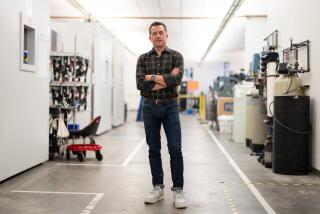At 88, billionaire inventor Alfred Mann’s motivated by more than money
Many executives would have given up after sinking a decade and $1 billion into an unsalable product.
Wall Street had hammered the company’s stock after regulators issued yet another round of safety concerns. Analysts piled on, some declaring the product would never reach the market. Shareholders sued.
But Alfred Mann’s motivations went far deeper than money.
The Los Angeles billionaire already could claim a stunning array of medical advances: His companies had created a rechargeable pacemaker; an implant that enables deaf people to hear; a prosthetic retina that helps blind people see; an insulin pump that transformed the treatment of diabetes; a device that enables amputees to control prosthetic fingers with their brains.
It was 2011, and Mann had his sights on inhaled insulin — a breakthrough that could spare millions of diabetics the pain of billions of daily pinpricks.
Mann ordered his executives to cancel all the company’s other projects, make painful job cuts and focus on the future of the drug, Afrezza.
The effort paid off. In June, the FDA blessed the drug, which led French pharmaceutical company Sanofi to pay MannKind Corp. $925 million for marketing rights, plus 35% of profits.
The deal could generate billions of dollars for MannKind. But for its chief executive — an 88-year-old physicist, inventor and entrepreneur who has launched 17 companies in five decades — it marks the capstone of a singular crusade.
“I know what motivates him,” said Keith Markey, a Griffin Securities analyst who covers MannKind. “He’d like to do as much as he can for humanity.”
Today, Mann walks a little slower than he once did. He’s recovering from two recent surgeries. But during an interview at his 17,000-square-foot estate in Beverly Hills, Mann said he still routinely works 70 hours a week, managing a portfolio of companies and a charitable foundation that he hopes will continue his efforts to find solutions for unmet medical needs long after he is gone.
“I’m trying to help people,” he said. “How else would I have been able to work until I’m almost 90, if I didn’t have something to motivate me?”
Business associates say it’s Mann’s tenacity — some call it stubbornness — that has fueled his companies’ success.
“He’s unwilling to give up,” said Robert Greenberg, chief executive of Second Sight Medical Products Inc., the company Mann co-founded to search for a cure for blindness.
During two years of testing for Second Sight’s “bionic eye” device, engineers had been unable to solve a significant problem: It kept tearing the eye tissue of animals on which it was tested.
A board member told Mann: Maybe this is just too hard. Maybe it’s impossible. Maybe we should quit.
Mann wouldn’t hear it.
“No way. This is just an engineering problem,” Greenberg recalled Mann saying. “And it’s solvable.”
In 2013, the Food and Drug Administration approved Second Sight’s Argus II System, a prosthetic retina that has helped some blind people see. Last month, the company filed for an initial public stock offering, touting Argus II as its most promising source of revenue.
“It was that recognition of when to quit — and when not to quit — that separates Al from others,” Greenberg said.
Mann was born and raised in Portland, Ore., the middle son of immigrants: his father from England, his mother from Poland. He graduated from high school at age 16, spent a couple of years in college and then joined the Army Air Corps during World War II, but didn’t see combat duty.
After the war ended, Mann settled in Southern California and helped his father tend to a lemon orchard before enrolling at UCLA, where he earned a degree in physics.
His first business breakthrough came in 1956, when the U.S. military hired him to improve guidance system technology for missiles, leading him to launch his first company, Spectrolab Inc. A few years later, he won a contract with Aerospace Corp. designing solar cells for spacecraft, leading to a second company, Heliotek Corp.
Mann sold both companies for $10 million in 1960, the equivalent of about $80 million in today’s dollars, plus a piece of future sales. In 1969, Johns Hopkins University researchers asked Mann if he could use space technology to help create a longer-lasting pacemaker.
Mann, whose father had died of a heart attack, responded with Pacesetter Systems Inc. It would become the nation’s second-leading supplier of pacemakers.
It also, unexpectedly, led Mann to take an interest in diabetes.
While running Pacesetter, Mann visited the cardiac intensive care unit at the University of Alabama in Birmingham. His host on the trip was heart surgeon Dr. Richard B. Shepard, who told him that every patient there recovering from heart surgery also had diabetes, including a man and woman who each had both legs amputated.
Shepard told him, in strong terms, that he should put his talents to work on diabetes.
“He must have taken this to heart,” Shepard said.
After selling Pacesetter to Siemens in 1985 for about $150 million, Mann began to focus on treatments for diabetes. His company MiniMed Inc. developed a small insulin pump that automatically delivers insulin throughout the day.
In 2001, Mann sold MiniMed to Medtronic Inc., a medical device giant, for more than $3 billion. The sale enabled Mann to focus on MannKind’s inhaled insulin — and on his own nonprofit charitable foundation, which researches and licenses medical products.
Mann also founded a company, Advanced Bionics, that manufactured cochlear implants to help deaf people hear. In 2004, he sold the company to Boston Scientific Corp. for $740 million, plus unspecified future payments.
“His passion, as he’s gotten older, is to try to eradicate as many terrible medical conditions as he can within his lifetime,” said David Hankin, chief executive of the Alfred Mann Foundation. “At the age of 88, the guy is prolific. He’s still inventing. We had a meeting a few weeks ago at his house to talk about some different forms of a device he’s thinking about. He had this amazing passion and gleam in his eye.
“His mind is as sharp as it’s ever been,” Hankin said. “I think he wakes up thinking about new devices every day.”
Last year, Mann teared up as he embraced retired Marine Corps Staff Sgt. James Sides at the Mann Foundation’s annual dinner.
Sides lost his right hand when a roadside bomb exploded on a dusty Afghanistan road in July 2012. Several months later, doctors at Walter Reed National Military Medical Center told him about a prosthetic hand that had been developed by the Alfred Mann Foundation. The device includes electrodes, implanted into arm muscles, that would enable him to intuitively move his prosthetic fingers. It was the most advanced prosthetic hand ever developed.
Surgeons implanted the new device in June 2013. Sides, now a student at Santa Monica College, said it has dramatically improved his life.
“It’s a whole new world,” he said. “I’m much more fluid with my daily tasks. I can pull money out of the ATM. Essentially, I’m acting as though I have a hand.”
Mann said meeting Sides was memorable.
“I get so much satisfaction out of helping people,” Mann said. “It’s not for money. My kids are well taken care of.”
Mann’s personal life has sometimes suffered while his businesses thrived. He has been divorced three times. He has spoken openly about his disappointment with some of his six children, whom he identified by birth order, rather than name, in an interview with The Times.
“My No. 5 kid has never worked. No. 6 has never worked,” he said. “No. 3 ran a restaurant and retired.”
Mann has said he intends to leave most of his fortune to his foundation and other charities.
“I’ve already given them too much,” he said, “so they’re not really motivated.”
Mann and his fourth wife, Claude Mann, have been married 10 years. They spend most of their time at their home in Las Vegas, where Mann works out of a home office. The couple spend quiet nights eating Claude’s home-cooked dinners — his favorite dish is chicken a l’Orange — and playing French rummy.
“He beats me most of the time,” she said. “That’s just the way his brain works.”
Claude forces her husband to take two weeks of vacations a year, one to Cabo San Lucas, Mexico. She’ll catch him reading business documents, checking emails, or quietly taking business calls when they’re supposed to be relaxing.
“I love him so much, so I don’t complain,” Claude said. “I know I will be first in his heart, but not his first priority. His first priority will always be work and doing what he does best.”
Recently, Alfred Mann has been focused on inhaled insulin. It’s been a long, expensive journey to get Afrezza to this stage. MannKind has spent about $1.8 billion developing Afrezza, with nearly $1 billion of that coming from Mann’s personal wealth, the entrepreneur said.
Investors have rewarded Mann’s persistence. MannKind shares, which sank as low as $2.25 in 2011, closed Friday at $6.68.
MannKind was a bystander in 2006 when Pfizer Inc. introduced the world’s first inhaled insulin product, Exubera, which it later yanked from the market because of poor sales, absorbing a loss of more than $2 billion.
Mann says Afrezza will succeed where Exubera failed because Afrezza has another benefit: It’s much faster-acting than insulin injections, in addition to being more convenient.
The drug is a powder that is inhaled with a device about the size of a whistle. It would be most often used to help control blood-sugar levels at meal time, a quick puff replacing an injection before a meal.
Those who know Mann are not surprised that he pushed Afrezza through.
“The guy is unrelenting,” said John Mastrototaro, who spent eight years working for Mann at MiniMed. “He recognizes that along the way you’re going to have certain setbacks.”
Still, Mastrototaro said he was concerned when he first heard of Mann’s plans for inhaled insulin.
“I actually thought it was a bad idea for him to get into the pharmaceutical space after all his success with devices,” he said. “Pharmaceuticals are just a different beast in terms of the time and money involved. But if anyone could get it done, it’s Al.”
Twitter: @spfeifer22







